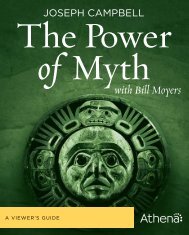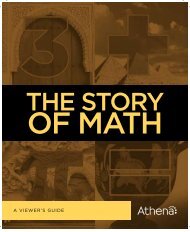THE CODE - Athena
THE CODE - Athena
THE CODE - Athena
You also want an ePaper? Increase the reach of your titles
YUMPU automatically turns print PDFs into web optimized ePapers that Google loves.
way. He established an important school for mathematics and philosophyin what is now Italy around the year 525 BCE. Pythagoras believed theuniverse could be explained in terms of whole numbers or their ratios.Although generally regarded as a philosopher, Plato is another of ancientGreece’s great mathematical pioneers. A student of Socrates and tutor ofAristotle, Plato founded the Academy in about 387 BCE and thereby madeAthens the world’s leading center of mathematics. Through a methodof logical discourse known as the dialectic, he pursued ultimate truths.Plato believed that mathematics provided an essential basis for deductivereasoning, and, like Pythagoras, that the universe could be understood inmathematical terms.A third Greek contender for the title “father of mathematics” is Euclid,who built upon the work of earlier mathematicians in order to develop asystematic approach to this area of study. Around 300 BCE, he authoredthe Elements, a treatise that codified much of the mathematical learningof the ancient world, and the Optics, the first composition on perspectivein ancient Greece. Euclid’s efforts did much to establish the foundationsof modern geometry, itself a product of the Greek words for “earth” and“measurement.”Finally, there’s Archimedes, a true polymath who excelled at all thingsmechanical and mathematical, and who developed the study of fluidpressure, or hydrostatics (another Greek word!). He was also a greatinventor, developing everything from siege engines to (probablyapocryphal) mirrors that could harness the power of the sun to igniteenemy ships. The Archimedes screw, a device that moves water to higherground, is still used for irrigation in some parts of the world today. Duringhis life, most of his mathematical achievements received less recognitionthan his practical inventions. His forays into pure mathematics, however,influenced students of the subject for millennia after his death.After the GreeksBy the first century BCE, Rome had conquered Athens—along with most ofwhat is now modern Greece—and Greek advances in mathematics came toan abrupt end. Rome shared none of the Greeks’ philosophical fascinationwith numbers, and for the practical Romans mathematics had purelypractical ends. For a thousand years, European traders and bureaucratswould have to work with a clumsy system of Roman numerals based on theletters of the Roman alphabet.Although the Romans were heirs to Greek civilization in so many otherareas, the Arabs of the Near East and North Africa took up that mantle formathematics. They added their own contributions—the words “algorithm”and “algebra” have Arabic roots—while also serving as a bridge to Easternlearning, bringing to the West breakthroughs from India such as the Hindu-Arabic system of numerals, trigonometric tables, and the concept of zero.In the centuries after the fall of Rome in 476 CE, Europe slid into adark age, during which the study of mathematics stagnated in the West.For monastics in Europe, the main application of mathematics was todetermine what day Easter would fall on. Eventually, trade with the Eastbrought exposure to earlier texts as well as newer works from the Islamicworld and, at the same time, an increased practical need for mathematicsfrom those engaged in commerce.The fall of Constantinople to the Ottomans in 1453 led to a further rebirthof classical learning in Europe. Greek scholars fleeing the Byzantinecapital brought with them many ancient manuscripts, which theircounterparts in Western Europe could now study firsthand. At the sametime in Europe, the development of the printing press helped disseminatethis newfound knowledge, allowing mathematics to regain its place as afoundational subject for the world.23
<strong>THE</strong> STORY OF PIRepresented by the Greek letter π (pi), the ratio of a circle’scircumference to its diameter is approximately 3.14—and formost people that would probably be close enough. But not formathematicians. That’s because π is an irrational number, a non-repeating,non-terminating number, which means that its decimal value goes onforever without any pattern. As a result, it is impossible to place anexact value on this most mysterious of numbers. Yet that hasn’t stoppedmathematicians over the millennia from trying.We don’t know just who first “discovered” π andthen tried to calculate it. But we do know thatthe ancient Babylonians got its value to 3.125 andthat Egypt’s Rhind papyrus records it as about3.16. However, it was Archimedes who firstcalculated π based on mathematical principles,instead of purely empirical measurements. Usingthe perimeters of two regular 96-sided polygons,one touching the inside edges of a circle and The Rhind papyrus, ca. 1650 BCEone circumscribing the outside, Archimedesdetermined that π must be between 3.14084 and 3.14285. The average of thesetwo numbers, 3.1418, is correct to the third decimal, and most basic mathproblems require the value of π only to the hundredth place.After Archimedes’s death, little advancement was made on the value ofπ for more than a thousand years in the West. Mathematicians in theEast and the Islamic world continued to make progress, however. Thecalculations of China’s Zu Chongzhi in the fifth century CE would notbe bettered until the Persian mathematician and astronomer al-Kashicalculated the value of π to 16 decimal places during the 1400s. Later, inEurope, mathematicians like Isaac Newton began to use infinite series tocalculate increasingly lengthy values for π.In the 20th century and beyond, computers took over the quest, and today πhas been calculated to ten trillion digits. Supercomputers notwithstanding,even the most modern values of π—like those of the ancients—continueas an approximation for a number whose elusiveness is commemoratedannually on Pi Day, 3/14.SITES BY <strong>THE</strong> NUMBERSIn the series, Marcus du Sautoy travels all over the world to illustrate thepower of the code. Among the places he visits are Chartres Cathedral inFrance, the Giant’s Causeway in Northern Ireland, and Grand Central Stationin New York. Below is a by-the-numbers look at each of these locations as wellas several others, both ancient and modern, natural and manmade.Chartres CathedralChartres is perhaps the finest example of FrenchHigh Gothic architecture and among the mostbeautiful of European cathedrals. Declareda UNESCO World Heritage Site in 1979, it isrenowned for its stained-glass windows and flyingbuttresses, the latter of which make possible itsheight and soaring interior spaces.427 ft Approx. length of the cathedral121 ft Approx. height of the nave54 ft Approx. width of the nave—theChartres Cathedralwidest in France350 & 380 ft Approx. height of the two spires186 Original number of stained-glass windows25,000 ft 2 Approx. area of the stained glass42 ft Approx. diameter of the labyrinth on the cathedral floor11 Concentric rings in the labyrinth© User: Atlant45
The Giant’s CausewayThe interlocking basalt columns rising out ofthe waters off the north coast of Ireland are theproduct of a cooling lava flow—or, according tolocal legend, a causeway built by an Irish giantso he could get at his Scottish rival. The Giant’sCauseway became a UNESCO World HeritageSite in 1986.50-60 million Years ago that the Giant’s Causeway was formed40,000 Approx. number of columns6 Number of sides of most of the columns82 ft Height of the tallest columns15-20 in Average diameter of the columns500 ft Approx. distance that the columns reach into the sea500,000 Tourists who visit the Giant’s Causeway every year2 miles Distance to the Old Bushmills Distillery, the oldestlicensed distillery in the world (founded 1608)Grand Central StationThe beloved Beaux Arts–style railroadterminal at the heart of New York City is,as measured by number of platforms, thelargest train station in the world. GrandCentral’s subway station is also the busieststop in the New York subway system.The Giant’s CausewayGrand Central Station’s main concourse750,000 People who pass through Grand Central Station every day21,600,000 Annual number of out-of-town tourists7 Subway lines serving the station80,000 ft 2 Size of the main concourse60 ft Height of the arched windows at each end of the mainconcourse© Users: Diliff and Janke2,500 Stars depicted in the great astronomical mural on theceiling of the main concourseMexico’s Cave of CrystalsDeep below the Chihuahuan Desert of northernMexico lies a limestone cavern that is home tosome of the largest known gypsum crystals inthe world. The crystals are extremely soft andeasily damaged, and were formed in heatedgroundwater that subsequently cooled.30 x 90 ft Dimensions of the Cave ofCrystals1,000 ft Depth of the cave below theearth’s surfaceGypsum crystals37.4 ft Length of the longest crystal55 t Weight of the heaviest crystals112˚F Approx. temperature within the cave90%–100% Humidity within the cave2 Hardness of gypsum on the Moh’s scale (talc is 1 anddiamond is 10)67
ParthenonSome experts claim that the Parthenon,Athens’s great temple to <strong>Athena</strong>, is based onthe golden ratio, a dimensional ratio that isconsidered the most pleasing to the humaneye. To further improve how the Parthenonis perceived, its columns bulge slightly inthe middle (a technique called entasis), anoptical refinement that makes them appearstraight.The Parthenon in Athens© User: AndyLiang79 ft Height of El Castillo45˚Angle of the four staircases52 Panels on each side of the pyramid, corresponding to thenumber of years in the Mayan cycle9 Terraces on each side, each of which are divided into twoby a staircase to give a total of 18, the number of monthsin the Mayan calendar91 Steps on each of the four sides, giving a total of 364 andcorresponding, when adding the temple platform as afinal step, to the number of days in the solar year228 x 101 ft Approx. dimensions of the Parthenon’s base at thetop step46 Exterior columns34 ft Approx. height of the exterior columns100,000 t Approx. amount of marble quarried and transported tothe site for the temple’s constructionEl Castillo, Chichén ItzáThe stepped pyramid of ElCastillo (“The Castle”) dominatesthe Mesoamerican settlementof Chichén Itzá in the YucatánPeninsula. Built for astronomicalas well as ceremonial purposes, thepyramid is topped with a templeto Kukulcán, the feathered serpentdeity of the Maya, whose shadowappears to wriggle down thestaircase during the spring and fallequinoxes.The snake revealed on El Castillo during thespring equinox© Angela CheneyCalifornia Polytechnic State UniversityThe Cal Poly campus incorporates within its design a spiral based on theFibonacci sequence, in which each number (after the second) is the sumof the two before it: 1, 1, 2, 3, 5, 8, 13, 21, etc. At Cal Poly, the spiral beginsin the middle of the EngineeringPlaza and links three corebuildings and various partsof the campus as it spirals outtoward the infinite.The Fibonacci spiralVisit our website for discussion questions and more informationon the full line of <strong>Athena</strong> programming.athenalearning.comBooklet written and edited by Robin Currie, Elizabeth Stocum, and Jennifer Coggins. © 2012 Acorn MediaGroup Inc. Some images licensed under Wikimedia Commons/CC BY-SA 3.0, CC BY 2.0, and CC BY 2.5.8 9
JOIN <strong>THE</strong>DISCUSSION!We want you to be a part of our funONLINE COMMUNITY. Get to know us,explore more <strong>Athena</strong> topics, and even winfree stuff!VISIT <strong>Athena</strong>Learning.com to watchvideos from all our <strong>Athena</strong> documentariesand delve deeper into the subjects thatinterest youFOLLOW us on Twitter(@<strong>Athena</strong>Learning) for contests,product announcements, and relevantnewsLIKE us on Facebook (<strong>Athena</strong>) tochat with other documentary fans, enterto win free DVDs, and check out exclusivevideo clipsAlso on DVD















